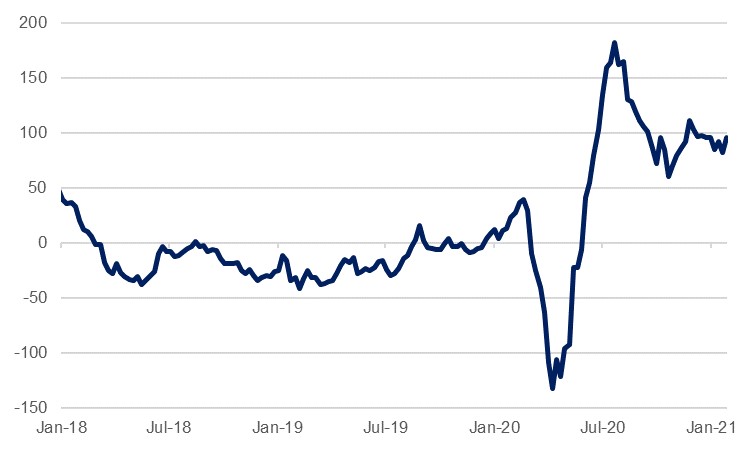
2021 has started the year on a positive footing, notwithstanding the chaotic scenes in Washington DC on January 6, and risk assets have gained momentum. There have been a number of developments which have contributed to these animal spirits, including hopes for a vaccine-driven herd immunity leading to an end to restrictions on movement and activity; the election of President-elect Joe Biden in November and the Democratic Party’s control of all three legislative elements of the US government after wins in the Georgia Senate run-offs in January; and the avoidance of a no-deal crash out of the EU by the UK as the Brexit transition period came to a close at the end of 2020. However, while these three developments are no doubt positive ones for the global economic recovery, there remain significant caveats. The year will certainly be a stronger one than the multi-generational shock we saw in 2020 – the IMF forecasts growth of 5.2% compared with a 2020 contraction of -4.4% – but the first half at least will remain highly challenging.
In November, a series of rapid-fire news updates regarding successful vaccine developments helped investors look ahead to a post-pandemic future, and there has been a greater note of optimism in discourse and in markets since. Subsequently, the start of vaccination rollouts in a number key markets around the world has reinforced the positivity. However, the administration of these vaccines is a huge logistical exercise, and with case numbers surging around the globe, the first quarter at the very least will likely remain characterised by ongoing lockdowns to varying degrees. New restrictions have recently been brought in Germany, the UK, Japan and other countries, and with vaccination programmes in the first instance generally targeting more vulnerable but often less economically productive citizens, the likelihood is that Q1 will see another economic contraction, and Q2 may also be quite weak.
.jpg) Source: Emirates NBD Research, IMF
Source: Emirates NBD Research, IMF
The hope, then, is that by the second half of the year the virus threat has dissipated to a sufficient degree to enable unfettered economic activity, potentially paving the way for a new ‘roaring twenties’. The significant savings made by many as they have worked from home and cut out their travel and socialising will enable them to unleash a burst of spending and facilitate a recovery in under-pressure industries such as hospitality and travel. However, this scenario is dependent both on concerns regarding the virus fading quickly, and on the elevated savings rate of some offsetting the rise in unemployment we have seen for others across the world. In this regard, government policy will be key, and governments will have to remain committed to the largescale support plans they put in place at the start of the crisis even as it becomes more costly and politically fraught to do so.
It is on the expectation of greater spending that the blue sweep of the US presidency and legislature has bolstered markets. President-elect Joe Biden has promised a pandemic relief plan costing ‘trillions’ of dollars in the wake of a surprise fall in jobs numbers in December, just the kind of action that will be needed to prevent the fallout of the pandemic crisis becoming entrenched as an economic one. However, while the Democrats do hold the House and the Senate, their control of the Senate is by the narrowest of margins, and is certainly short of the 60-seat majority needed to push through filibuster-proof legislation. Further, more moderate members of the Democratic Party have already pushed back against some of the numbers being bandied about. Some more support spending seems likely, but the chance of it reaching the figures touted by the incoming president seem unlikely, while massive investment in new big-ticket infrastructure projects will be even more constrained. Combined with likely measures to try and control the surge in coronavirus cases, we are fairly cautious on US growth this year, projecting a 3.6% expansion.
In the UK, the 11th hour signing of a trade deal between the UK and the EU at the end of 2020 removed one of the most salient threats to the UK (and to an extent EU) economy, one that has arguably been hanging over it since the Brexit referendum in 2016. The deal means that there will not be tariffs and quotas on the UK’s trade in goods with the 27-nation bloc, which accounts for around half of the UK’s total trade. UK assets, which have underperformed compared to their global counterparts, have rebounded strongly in the wake of the deal, with GBP at levels last seen in H1 2018 and the FTSE 100 one of the strongest performing equity indices so far this year.
 Source: Bloomberg, Emirates NBD Research
Source: Bloomberg, Emirates NBD Research
While the deal is certainly better than no deal, it is not better than what the UK had before in terms of its free and easy trade with Europe. There might not be new tariffs, but new checks over aspects such as rules of origin mean increased paperwork and frictions, and higher costs according to many companies. Meanwhile, the deal leaves major questions regarding the services sector, which accounts for half of the UK’s exports, unanswered. Given the pandemic-led disruption, it will be hard to disentangle the effects of this new trading relationship on growth from that of the renewed lockdowns, but we are below consensus on the UK this year, projecting an expansion of 4.5% compared to Bloomberg’s consensus 5.2%.